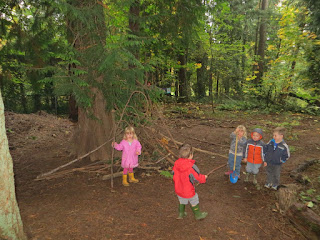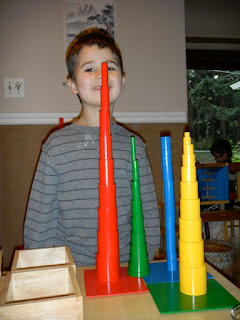"The land is where our roots are.
The children must be taught to feel and live
in harmony with the earth."
in harmony with the earth."
Maria Montessori
 Isabel has been engaged in this creation of sticks down in the forest since her first week with us a month ago. It's a castle, a hiding place, a fort, a work of art, and it is largely her project, although she allows other kids to add to it occasionally. (I've had to protect it a bit from destruction!) It is balanced, intricate, and utterly natural. Watching her, a new Chickadee child engaged in our outside environment for the first time, has inspired me to reflect again on the profound importance of the children spending time outside, daily, in this natural landscape.
Isabel has been engaged in this creation of sticks down in the forest since her first week with us a month ago. It's a castle, a hiding place, a fort, a work of art, and it is largely her project, although she allows other kids to add to it occasionally. (I've had to protect it a bit from destruction!) It is balanced, intricate, and utterly natural. Watching her, a new Chickadee child engaged in our outside environment for the first time, has inspired me to reflect again on the profound importance of the children spending time outside, daily, in this natural landscape. So I am reflecting on these children in our woods, and it's Isabel and her sticks, and Rex connecting with a tree, and Lucas discovering the mushrooms, and Brady and Charlotte raking - and it's the beauty of the fall in general - and it's all of these together - that I want to share with you. Most of you do not have the freedom to spend your days in nature. But this is what you have made possible for your children. When looking out our big back window this week, in the midst of whatever part of his or her day, this view is what has beckoned your children. This is what has filled their eyes.
So I am reflecting on these children in our woods, and it's Isabel and her sticks, and Rex connecting with a tree, and Lucas discovering the mushrooms, and Brady and Charlotte raking - and it's the beauty of the fall in general - and it's all of these together - that I want to share with you. Most of you do not have the freedom to spend your days in nature. But this is what you have made possible for your children. When looking out our big back window this week, in the midst of whatever part of his or her day, this view is what has beckoned your children. This is what has filled their eyes.  For this precious, transient season, we have had the beauty of leaves from our Japanese maple, with leaf pressing and leaf raking and leaf piling and kids jumping and wheelbarrow pushing to the chicken yard. It's so fun, and so impermanent. We sing several autumn songs these days, and one favorite has this refrain: "Days of in between, see the changing scene, autumn time is all around." Its melody, in a minor key, has a magical hold on the children, and they sing it well. Perhaps it helps confirm with music these inexpressible moments of connection with nature.
For this precious, transient season, we have had the beauty of leaves from our Japanese maple, with leaf pressing and leaf raking and leaf piling and kids jumping and wheelbarrow pushing to the chicken yard. It's so fun, and so impermanent. We sing several autumn songs these days, and one favorite has this refrain: "Days of in between, see the changing scene, autumn time is all around." Its melody, in a minor key, has a magical hold on the children, and they sing it well. Perhaps it helps confirm with music these inexpressible moments of connection with nature. Meanwhile, out the front window, "I'm back!" Our Anna's hummingbird returned a few weeks ago. I am quite convinced that it's the same single or pair who were with us all last winter and spring, and who then migrated elsewhere for summer. Now he and/or she stops at the feeder on the front porch many times a day, up close and personal for the kids.
Meanwhile, out the front window, "I'm back!" Our Anna's hummingbird returned a few weeks ago. I am quite convinced that it's the same single or pair who were with us all last winter and spring, and who then migrated elsewhere for summer. Now he and/or she stops at the feeder on the front porch many times a day, up close and personal for the kids. Someone is always calling out, "There's the hummingbird!"
And behind the hummingbird has been this last, amazing, and somewhat aberrant cosmos, which burst into bloom long after all the other cosmos were finished. Our last flowers of 2012 for sure.

Of course, the rains came back, and so did the mushrooms. Once again, I am resolving to take a mushroom-identification class, or at least get a good book, because I don't know them at all, and when I google these specimens, it's overwhelming. First we had what we call "fairy mushrooms," little delicate white ones, all over the forest. Then a few patches of this very large and sturdy species developed, and they are still appearing. Simultaneously, a delicate dancer of a mushroom showed up right in our path. These didn't last long, though we tried to protect them with a tent of sticks. There's only so much we can do....
And of course the trees. Our beautiful blessed trees. Rex was just hanging out close to this Douglas fir a few days ago, experiencing it, looking closely at its bark. He leaned up against the trunk and so I encouraged him to turn his head up, to follow the trees with his eyes all the way as far as he could see. My camera couldn't do the sight justice, but I tried, and you get the idea. All Rex could say was, "Wow." It was a beautiful, peaceful moment.
"There is no description, no image in any book that is capable of replacing the sight of real trees, and all the life to be found around them in a real forest." These are Maria Montessori's words, written so many years ago. She seems to me to have been standing in a direct line which connects William Wordsworth to John Muir to Richard Louv, with herself speaking with such prescience for the child in nature. IN nature, with flowers and mushrooms and trees and birds and all the inexpressible, amazing manifestations of the one Life that animates us all.












































